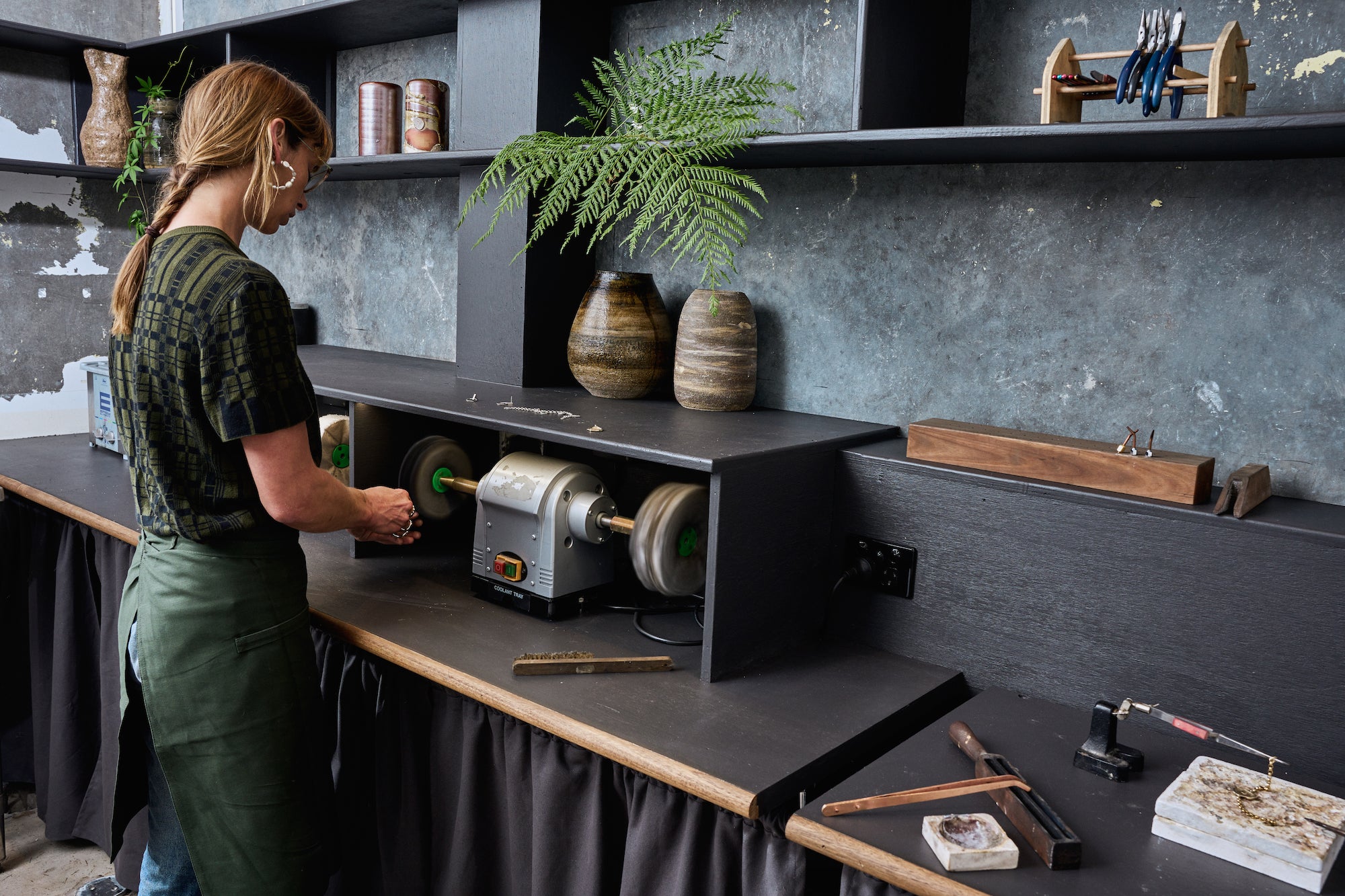
Holly’s Reverence collection. Images by Kelly Geddes
What was the industry like when you started designing and making jewellery, and how have you seen it evolve?
When we were studying fashion, fast fashion was on the rise. I saw a gap in the market for high end hand-crafted jewellery. I was seeing either a lot of tacky costume jewellery or mainstream makes from Wallace Bishop, and it was when handcrafted was still hippy-ish. I was inspired by Karen Walker’s jewellery range at the time, who is a New Zealand-based designer, but I wanted to do locally-made Aussie iconography. I was lucky to have parents that studied jewellery making and they helped me start making my own. Thea Basilou of one of Brisbane’s best boutiques at the time, Blonde Venus, could see the unique approach and she picked up my designs before I graduated!
 Holly crafts many of her pieces by hand. Image by Alycia Rubulis
Holly crafts many of her pieces by hand. Image by Alycia Rubulis
I was taught by my mum but picked up short courses in diamond setting, wax carving, cold joining, and more, as I continued to learn on the job. Mum’s still on the team, and now we're an Australia-wide brand. Since launching, there have been countless entrants on the market which is a sign of how people have come to value locally and sustainably made jewellery.
Let’s start with materials and where they come from. The jewellery industry is rife with sourcing issues and there’s lots of opacity in the supply chain. How do you navigate that?
The key materials we work with are sterling silver and all carats of solid gold which we source from recycled metal supplies in Australia. We source pearls from Australian pearl farms, ethically-mined precious gems through local suppliers and sapphire beads through fair-trade suppliers in India, which support women in domestic violence situations, whom I’ve worked with in person. I also buy second hand gemstones to be re-facated and second hand gold jewellery to melt down and re-use. We now also source lab-grown diamonds so we’re not mining the earth for these.
 Emeralds, pearls and metals are sourced ethically both in Australia and overseas. Image by Kelly Geddes (right)
Emeralds, pearls and metals are sourced ethically both in Australia and overseas. Image by Kelly Geddes (right)
There is a lot of privacy and secrecy in the precious stones industry, which is why I like to salvage that which is discarded or seen as less-than-luxury by the industry at large. My customers appreciate a more organic aesthetic, and via the process of upcycling and recycling I can tell the story of beauty in imperfection and the transience of nature.
How did circularity come into your awareness and what role does recycling metals and other materials play in your making process?
Based on my upbringing and environment I was always respectful of materials and where they came from. I grew up on the Sunshine Coast and the proximity to nature and way of life instilled in me an environmentally conscious mentality. That, and watching my parents make things by hand. I was sewing clothing at 8 or 9 years of age, candle-making, potato-printing and all those hand-on creative activities.
So upon launching my brand, many of my approaches were a given including buying recycled metal and recycling metals, melting some of it down in-house. When the metal becomes molten it looks like a puddle – from there we roll it out into a sheet, and create new wire and unique shapes.
 Making in house means you can more easily care for, repair and extend the life of the products you produce. Image by Dylan Pukall
Making in house means you can more easily care for, repair and extend the life of the products you produce. Image by Dylan Pukall
In educating customers about the value of metals and stones (precious metals don’t lose value, only increase in value), we started to take custom orders re-fashioning old jewellery and offering repairs, replating and recycling services to extend the life cycle of our (and other!) jewellery pieces.
What is your design philosophy and how is this reflected in your aesthetic?
Hand-making has always been really important to me. At fashion school, everything was hand-lined and hand-seamed and I would painstakingly match all the tartan lines in a perfectionist, pedantic way. Keeping traditional craftsmanship alive is my passion, and timeless design and quality making prolongs product lifespan from the outset.
I also like to design with materials I have in the studio before I source from anywhere else. I draw from old collections and pieces I’ve bought from a second hand gemstone market. This way I have to think more creatively, asking myself, ‘how can I make this new and ingenious?’. I’m buying less, but am creating better value, which is a more sustainable business practice in itself.
 Holly on the polishing wheel. Image by Dylan Pukall
Holly on the polishing wheel. Image by Dylan Pukall
I am endlessly inspired by nature, and that which is naturally occurring. So I find the process of making itself inspiring. For example, I might have an idea but it’s in the process of shaping it into a real thing that might take me down another path. Not being attached to the outcome is important, and the process of hand making is obvious in the piece, like the Wabi Sabi series of rings and earrings.
What was it like to move from Sydney to Noosa? I’ve heard you say your creativity boomed upon moving!
Yes, after living in Brisbane for 9 years, I was Sydney-based for almost 5 years, moving back up the coast mid-2021. Reconnecting to nature after working in the middle of the city was incredible. For me, nothing is as healing as a barefoot walk in the bush or floating in the ocean.
 Holly’s latest collection, El Agua Magica is an ode to the ocean and the origin of her jewellery making skills, Mexico. Images by Taylah Golden
Holly’s latest collection, El Agua Magica is an ode to the ocean and the origin of her jewellery making skills, Mexico. Images by Taylah Golden
Upon coming home, I felt grounded and renewed, connecting back to myself and even my childhood, which is where the collection El Agua Magica came from.
 Holly wielded a chainsaw to create this reclaimed wood collage wall for her shop
Holly wielded a chainsaw to create this reclaimed wood collage wall for her shop
I also had space and time to learn how to use a chainsaw, sourcing local harwoods from scrap yards to continue my sculpture practice. We opened the store in Noosa in October last year and it gave me a sense of girlpower to fit out my own store with my own woodwork, in the form of wooden lamps, mirrors, shelves and a wooden collage wall. The store has our two workshops attached, so we make almost all of our jewellery here in Noosa, on view to the public.

How does making locally allow you to implement circularity into your business model?
Our Noosaville shop is in a creative hub which includes a brewery, barber shop, surfboard factory, jujitsu and movement studios, shared office spaces and an art gallery. These businesses share accounting services and even staff. One of the barbers is going to come work with us! He’ll be starting on the polishing wheel and we’ll teach him in between haircuts.
Together we exchange knowledge about what’s working and support one another to grow our businesses together. We also have other local makers and designers in store, like ceramicist Tess Miller, Woven Palm locally made shoes, teas and incense, and of course Seljak Brand blankets.
 The workshop can be seen from the retail space, with includes the work of local designers as well as Holly's own
The workshop can be seen from the retail space, with includes the work of local designers as well as Holly's own
Working locally reduces carbon emissions, allows us to work with other local suppliers and employ our own staff. In building strong ties with people in the community we create a more resilient local business network overall.

